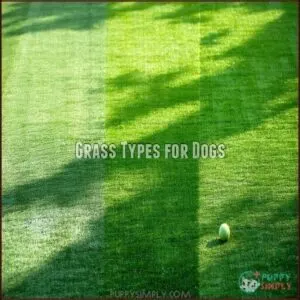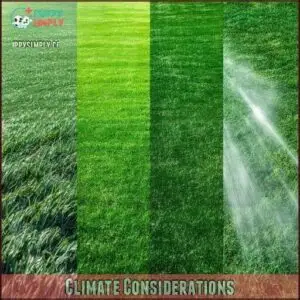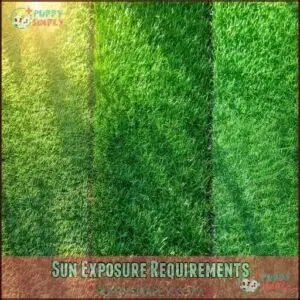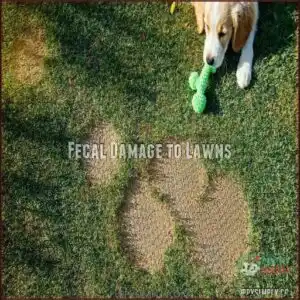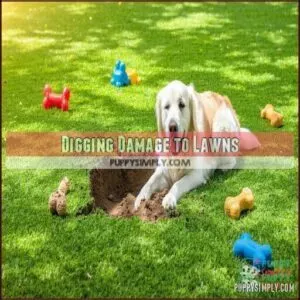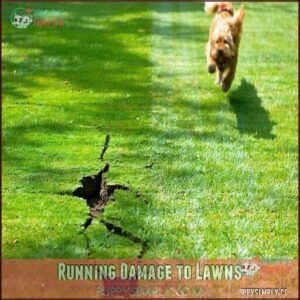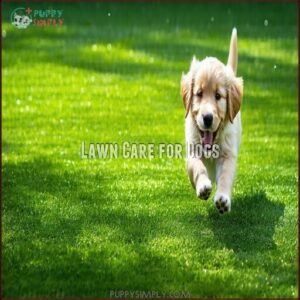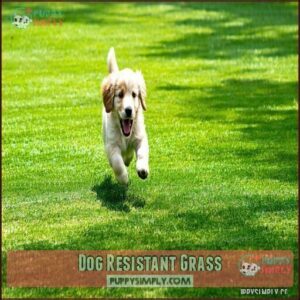This site is supported by our readers. We may earn a commission, at no cost to you, if you purchase through links.
 For the best grass for dogs, you’ll want tough varieties that can handle your four-legged friend’s activities.
For the best grass for dogs, you’ll want tough varieties that can handle your four-legged friend’s activities.
Kentucky Bluegrass offers excellent recovery from traffic damage, while Tall Fescue resists urine spots and drought. Bermuda grass thrives in warm climates and repairs quickly after wear.
Perennial Ryegrass establishes fast and withstands heavy use. Your ideal choice depends on your climate zone and sun conditions.
The perfect dog-friendly lawn isn’t just about picking hardy grass—it’s about creating a balance between your pup’s play space and a yard that won’t turn into a muddy mess after the first game of fetch, considering the need for a lawn that repairs quickly.
Table Of Contents
- Key Takeaways
- Dog Friendly Lawn Options
- Grass Damage Prevention
- Best Grass Types
- Lawn Care for Dogs
- Dog Resistant Grass
- Frequently Asked Questions (FAQs)
- What is the best grass when you have dogs?
- What is the best lawn for dogs?
- What type of grass is most resistant to dog urine?
- Is zoysia or bermuda better for dogs?
- Are some grasses better for homes with dogs?
- Is fescue grass good for dogs?
- What is the best grass for dogs?
- Are cool-season grasses good for dogs?
- Which grass is best for dog Pee?
- What kind of grass does a dog eat?
- Conclusion
Key Takeaways
- You’ll want climate-appropriate grass varieties for your dog’s yard—Kentucky Bluegrass for cooler regions and Bermuda grass for warmer areas offer the best balance of durability and recovery.
- Your dog’s urine can cause nitrogen burn on grass, but you can minimize damage by selecting urine-resistant varieties like Tall Fescue or Perennial Ryegrass and diluting spots with water immediately.
- You’ll need to match your grass to your yard’s sun exposure—Bermuda thrives in full sun, Kentucky Bluegrass and Tall Fescue work well in partial shade, and Fine Fescue is your best option for heavily shaded areas.
- You can repair and prevent lawn damage by aerating annually, using pet-safe fertilizers, and establishing designated play areas to reduce wear patterns from your dog’s running and digging.
Dog Friendly Lawn Options
You’ll find several grass varieties specifically engineered to withstand your dog’s daily activities, from urine spots to enthusiastic digging and running.
The ideal dog-friendly lawn combines rapid regrowth, deep root systems, and climate-appropriate species that can handle high traffic while maintaining an attractive appearance.
Grass Types for Dogs
Creating a dog-friendly paradise begins with selecting the right grass types for dogs that can withstand your furry friend’s activities.
- Kentucky Bluegrass boasts impressive self-healing properties with blue-hued blades for both dogfriendly lawn appeal and durability
- Tall Fescue benefits include excellent moisture absorption and shade tolerance, perfect for areas with varied sun exposure
- Ryegrass hardiness makes it ideal for quick repairs in high-traffic zones
- Zoysia density creates a luxurious carpet that stands up to active pups
- Bermuda durability is unmatched in warm climates, similar to sports field turf
The right petfriendly grass transforms a patchy yard into a resilient, lush lawn that both you and your dog will love, with impressive self-healing properties and luxurious carpet.
Climate Considerations
After selecting dog-friendly grass varieties, you’ll need to match them to your climate for success.
Cool-season grasses like Kentucky Bluegrass and Fescue thrive in northern regions (40-75°F), while warm-season options like Bermuda and Zoysia excel in southern heat (75-95°F).
Your regional climate determines grass temperature tolerance and recovery from paw traffic.
Consider rainfall impact and humidity effects too—some varieties handle moisture better than others. If you’re in a zone with mixed conditions, you might need a blend that can withstand seasonal changes throughout the year.
Sun Exposure Requirements
Matching your lawn’s sun exposure to the right grass guarantees it thrives against your pup’s playful paws.
Here’s a breakdown based on sunlight needs:
- Full sun (6+ hours daily): Bermuda and zoysia grass excel here, handling heat and high traffic.
- Partial shade: Tall fescue or Kentucky bluegrass adapt well.
- Heavily shaded areas: Look for shade-tolerant fescue varieties.
- Regional variations: Assess your yard’s sunlight exposure to choose the best sun-tolerant or shade-tolerant grass.
To keep your pets safe, consider using pet-safe lawn fertilizer on your grass.
Healthy grass equals happy paws!
Grass Damage Prevention
Protecting your lawn from dog-related damage starts with understanding how activities like urination, digging, and running impact grass health.
By taking simple steps like proper cleanup and encouraging good habits, you can help your yard stay lush and strong.
Urine Damage to Grass
Dog urine can quickly lead to nitrogen burn, causing those unsightly yellow or brown patches on your lawn.
It happens because of the high nitrogen levels in your pup’s urine, especially if their diet is protein-heavy. A dog’s habit of repeatedly using the same spot worsens the damage.
To counteract this, try watering strategies to dilute nitrogen immediately after they go. Adjusting soil pH and using soil amendments can also promote grass recovery.
Choose urine-resistant grass for dog urine damage prevention and better longevity. Using pet safe lawn fertilizer can also help maintain a healthy lawn.
Fecal Damage to Lawns
A dog’s waste doesn’t just ruin your lawn’s look—it disrupts soil microflora and introduces harmful bacteria.
The nitrogen buildup from pet waste creates brown patches and weakens grass health.
Regular cleanup and waste management are key to preventing lawn damage and maintaining a lush yard.
Here’s how you can reduce the harm:
- Pick up waste daily to prevent nitrogen buildup and bacteria introduction.
- Train your dog to potty in a designated spot, easing lawn recovery.
- Rinse affected areas to dilute nitrogen and promote healthy regrowth.
Digging Damage to Lawns
Digging can turn your yard into a crater-filled mess, compacting soil and tearing grass. Certain breeds dig more due to instincts, so choose durable grass with deep root development, like tall fescue.
To dogproof, use redirection strategies—sandboxes or toys—and repair damage promptly. One effective strategy involves purchasing digging deterrents to protect your lawn.
Here’s a helpful guide:
| Digging Factor | Impact on Lawn | Prevention Tips | Grass Recommendation |
|---|---|---|---|
| Fun | Soil compaction | Provide play distractions | Tall Fescue |
| Heat Escape | Grass uprooting | Add shaded areas | Bermuda Grass |
| Breed Predisposition | Persistent digging | Offer digging zones | Perennial Ryegrass |
| Burying Objects | Uneven surface | Use sand/mulch spots | Kentucky Bluegrass |
The key to preventing persistent digging is to understand the underlying reasons, such as breed predisposition, and address them with the right strategies, including providing play distractions and using digging deterrents. By following these tips and choosing the right grass recommendation, you can protect your lawn from damage.
Running Damage to Lawns
When your dog zooms around the yard, the result is often compacted soil, blade crushing, and turf dislodging, which lead to bare patches and increased erosion risk.
To reduce running damage, choose durable grass like Kentucky Bluegrass or Perennial Ryegrass.
Encourage dog activities in specific areas, and maintain lawn durability with proper watering and aeration. These steps combat dog-induced damage effectively while keeping your yard lush.
Best Grass Types
Choosing the right grass for your yard guarantees it can handle your dog’s energy while still looking great.
Tough varieties like fescue and Bermuda are durable, easy to maintain, and suited to high-traffic areas.
1. Tall Fescue Grass Seed Blend
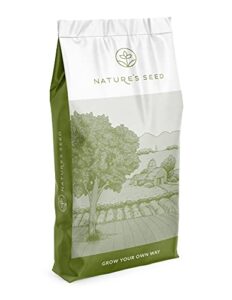
In the case of dog-friendly grass, tall fescue is tough to beat.
Its deep roots handle heavy paw traffic, while the wide blades resist wear and tear.
This adaptable grass thrives in various climates and soaks up moisture efficiently, minimizing pet damage.
For best results, plant it in slightly acidic, well-draining soil.
Regular mowing and maintenance keep it looking lush.
Bonus tip: choose all-natural seed blends for extra pet safety!
Best For: Families and pet owners seeking a durable, low-maintenance lawn that thrives in various climates.
- Deep root system handles heavy traffic and reduces pet damage.
- Thrives in diverse climates and adapts to different soil types.
- Resistant to drought, wear, and common turf diseases.
- Requires proper soil preparation for optimal results.
- Mixed reviews on weed presence and delivery quality.
- Needs consistent maintenance for best appearance.
2. Kentucky Bluegrass Lawn Grass Seed
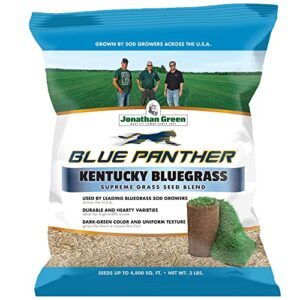
Renowned for its self-healing properties, Kentucky Bluegrass creates a perfect playground for your canine companions.
This cool-season grass develops a network of underground rhizomes that quickly repair paw traffic damage, making it remarkably resilient.
You’ll appreciate its lush, blue-green appearance that stays beautiful despite daily dog activities.
It thrives in USDA zones 2-6 with soil pH between 6-7, requiring full sun to partial shade for ideal growth.
While it takes 21-28 days to germinate, the durability you’ll gain is worth the wait for a beautiful and tough lawn.
Best For: Homeowners seeking a durable, pet-friendly lawn with a lush, blue-green appearance that can withstand high traffic.
- Resilient against pet and foot traffic damage due to self-repairing rhizomes.
- Creates a dense, aesthetically pleasing blue-green lawn.
- Thrives in a variety of conditions, including partial shade and USDA zones 2-6.
- Takes up to 28 days to germinate, requiring patience.
- Requires consistent moisture for successful establishment.
- Prone to nitrogen burn spots from dog urine.
3. Wear Tolerant Perennial Rye Grass
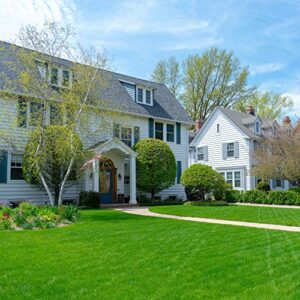
With exceptional resilience against paw traffic, Perennial Ryegrass stands as the champion choice for homes with large or multiple dogs.
It germinates within just 4 days and establishes a robust lawn in 2 weeks, offering remarkable recovery from pet damage.
You’ll appreciate its natural urine tolerance and outstanding wear resistance—perfect for active dogs who love to play.
Its fine-textured, slender blades create a dense surface that withstands daily pet activity while maintaining a vibrant green appearance.
For cooler climates, this grass delivers unmatched durability without sacrificing appearance.
Best For: Homes with large or multiple dogs in cooler climates, seeking a durable, urine-tolerant, and vibrant green lawn.
- Rapid germination and establishment, ready in 2 weeks.
- Excellent wear resistance and natural urine tolerance.
- Fine-textured blades offering a dense and lush appearance.
- Requires consistent watering and maintenance for best results.
- May demand more fertilizer compared to other grasses.
- Mixed reviews regarding weed presence post-germination.
4. Bermudagrass Seed for Full Sun Lawns
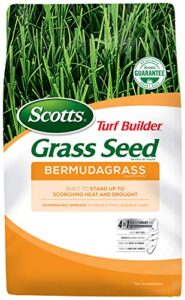
Your pup’s playground will thrive with Bermudagrass, especially in sun-drenched yards.
This warm-season champion offers:
- Superior heat and drought resistance
- Exceptional traffic tolerance from active dogs
- Quick recovery from damage
- Deep root system (reaching up to 6 feet)
- Aggressive spreading to fill bare spots
Perfect for USDA zones 6-10, Bermudagrass demands full sun (8+ hours daily) and rewards you with a tough, dense lawn that stands up to even the most energetic four-legged friends.
Consider using organic lawn food for safer fertilization.
Best For: Pet owners with high-traffic, sunny lawns looking for a durable and drought-resistant grass option.
- Requires consistent watering and proper soil prep for success.
- Limited performance in shaded or low-sun areas.
- Mixed user reviews, particularly in specific climates like North Florida.
- Superior heat and drought resistance for full sun areas.
- High tolerance for foot traffic and active pets.
- Aggressively spreads to fill bare spots and maintain a thick lawn.
Lawn Care for Dogs
You’ll need specific maintenance strategies to keep your lawn healthy while accommodating your four-legged friends.
Proper lawn care techniques, including regular aeration, targeted fertilization, and prompt repair of urine spots, will help your grass withstand the unique challenges that dogs present, using proper lawn care techniques and targeted fertilization.
Repairing Pet Urine Spots and Damage
Frustration with yellow spots on your lawn can disappear with proper pet urine damage repair techniques. When your dog’s urine causes nitrogen burn, quick action is essential for recovery.
To repair pet urine spots and promote lawn recovery:
- Dilute fresh urine immediately by watering the area thoroughly to minimize grass burn prevention
- Test and adjust soil pH balance using gypsum or lime to neutralize acidic conditions
- Try reseeding bare spots with urine-resistant grasses like Kentucky Bluegrass or Tall Fescue
- Apply dog-safe fertilizers that support root development without harsh chemicals
Watering techniques make a significant difference—deep, infrequent watering encourages stronger roots than frequent light sprinkles. For stubborn damage, alternative treatments like activated charcoal can absorb excess nitrogen. Effective solutions for pet urine repair can restore your lawn’s health. Remember that different grass varieties have varying levels of natural urine resistance, so selecting the right grass type is your first defense against lawn damage.
Aeration and Dethatching for Healthy Lawns
Two essential lawn care practices help your grass withstand dog traffic: aeration and dethatching. Dogs can contribute to soil compaction, restricting root health and water penetration.
- Core aeration creates small holes that allow oxygen, water, and nutrients to reach grass roots
- Removing thatch buildup prevents the spongy layer from blocking moisture
- Annual lawn maintenance should include both practices for ideal soil health
- Use a manual or mechanical aerator depending on your lawn size
These techniques strengthen your lawn’s resilience against paw traffic while improving overall turf health—think of it as giving your grass a breathing treatment! Many options exist for selecting an aerator.
Fertilization and Pest Control for Dog Owners
When choosing fertilizers and pest controls, your dog’s safety comes first.
Opt for pet-safe fertilizers that won’t harm your furry friend if they decide to roll in the freshly treated grass. Consider using natural fertilizer options to minimize risks to your pets.
| Product Type | Pet-Safe Options | Waiting Period |
|---|---|---|
| Fertilizers | Organic compost | Until dry |
| Weed Control | Vinegar solution | 1-2 hours |
| Lawn Pests | Nematodes | None |
| Tick Prevention | Diatomaceous earth | None |
| Soil Health | Compost tea | None |
Always wait until treatments dry completely before allowing your pup back on the lawn.
Dog Resistant Grass
You’ll need grass varieties specifically engineered to withstand the constant trampling, digging, and nitrogen-rich deposits that come with canine companions.
Selecting dog-resistant grass requires consideration of growth rate, root depth, climate compatibility, and sun exposure to guarantee your lawn remains lush despite your four-legged friend’s best efforts to destroy it, ensuring a lush lawn.
Rapid Growth Rate for Quick Recovery
When dogs tear up your lawn, rapid growth rate comes to the rescue.
Fast-growing grass varieties like Kentucky Bluegrass and Perennial Ryegrass offer impressive self-repairing lawns thanks to their superior seedling vigor and quick establishment properties.
You’ll benefit from overseeding these varieties regularly, as their germination speed guarantees damaged areas bounce back faster.
These resilient grasses maintain consistent lawn recovery rates, keeping your yard looking pristine despite your four-legged friend’s best efforts to tear it up with their superior seedling vigor.
Deep Root System for Damage Resistance
While fast growth helps your lawn bounce back, deep roots act as your grass’s secret weapon against playful pups.
Bermudagrass, Kentucky Bluegrass, and Zoysia all develop impressive root systems that enhance soil stabilization and erosion control.
These robust networks improve water absorption and nutrient uptake, making your dogproof lawn more resilient when Fido digs or races across it.
For a truly dog-resistant yard, prioritize grasses with strong, deep-reaching roots that anchor firmly into the soil, creating a lawn with deep roots.
Climate-Appropriate Grass Selection
Picking up the right regional grasses can make or break your dog-friendly lawn.
Cool-season grass thrives in northern zones with cold winters, while warm-season grass loves southern heat.
Your yard’s microclimate factors—temperature tolerance, humidity impact, and seasonal adaptation—determine climate suitability.
In intermediate zones, consider blends for year-round coverage to create a lawn that can handle your pup’s playful antics.
Match grass types to your specific conditions for a lawn that can handle your pup’s playful antics.
Matching Grass to Sun Exposure
Your lawn’s sun exposure is just as important as climate when selecting dog-resistant grass.
For yards bathed in full sun, Bermuda grass stands strong against your pup’s activities.
Kentucky bluegrass and tall fescue excel in partial shade areas, offering resilience and beauty.
Dealing with dense shade? Fine fescue is your shade-tolerant ally.
Remember to map your yard’s sunlight patterns—matching grass varieties to specific sun exposure guarantees both your lawn and furry friend will thrive together!
Frequently Asked Questions (FAQs)
What is the best grass when you have dogs?
Like a sturdy shield for your active playground, Kentucky Bluegrass offers the best protection when you’ve got dogs.
It’s durable, heals quickly after damage, and thrives in cooler climates with its attractive blue-hued blades, making it a great choice for pet owners who want a blue-hued lawn.
What is the best lawn for dogs?
Kentucky Bluegrass offers the perfect balance for your furry friends – it’s durable, heals quickly from paw traffic, and thrives in cooler climates.
For warmer regions, Bermuda grass stands up beautifully to active dogs.
What type of grass is most resistant to dog urine?
Perennial Ryegrass handles your pup’s "liquid deposits" best.
You’ll find it’s highly urine-tolerant, hardy, and perfect for homes with multiple dogs.
It thrives in cooler climates but needs regular watering and feeding.
Is zoysia or bermuda better for dogs?
Both have advantages: Bermuda heals faster from damage but needs full sun, while Zoysia’s density handles paw traffic better but takes longer to establish.
You’ll want Bermuda for active dogs and Zoysia for a luxurious, traffic-resistant yard.
Are some grasses better for homes with dogs?
Yes, certain grasses handle dog traffic better than others.
You’ll want fast-healing varieties like Kentucky Bluegrass, Bermuda, or Fescue that can withstand pawing, playing, and those occasional "bathroom breaks" your furry friend needs.
Is fescue grass good for dogs?
Fescue grass is excellent for dogs, offering hardy resilience to paw traffic and urine damage.
It’s highly absorbent, shade-tolerant, and low-maintenance, making your yard both beautiful and functional for your furry friends.
What is the best grass for dogs?
The ideal grass for your dog depends on your climate.
For cooler regions, Kentucky Bluegrass or Perennial Ryegrass work well, while Bermuda or Zoysia are better for warmer areas.
Choose varieties with deep root systems.
Are cool-season grasses good for dogs?
In the case of man’s best friend, cool-season grasses like Kentucky bluegrass, fescue, and perennial ryegrass are hitting the nail on the head.
They’re durable, urine-tolerant, and recover quickly from paw traffic.
Which grass is best for dog Pee?
Perennial Ryegrass stands out as your best option for dog urine areas. It’s remarkably urine-tolerant, recovers quickly from damage, and thrives in most climates where dogs frequently relieve themselves.
What kind of grass does a dog eat?
Your dog naturally gravitates to dog grass (Agropyron repens), wheatgrass, or tall wild grasses when seeking fiber or chlorophyll.
They’ll instinctively choose tender blades that help with digestion or to induce occasional therapeutic vomiting, utilizing chlorophyll for their needs.
Conclusion
While initial installation costs might seem higher, the long-term savings of selecting the best grass for dogs will outweigh frequent lawn repairs.
You’ll enjoy watching your pup play on resilient turf that bounces back from traffic, resists those dreaded urine spots, and stands up to weather extremes.
By matching your grass type to your climate and sun conditions, you’ll create a sustainable, beautiful lawn that both you and your four-legged friend can enjoy for years.
- https://trysodpods.com/blogs/inspire/the-best-grass-for-dogs-ranked
- https://geckogreen.com/best-grass-for-dogs
- https://www.lawnstarter.com/blog/lawn-care-2/best-grass-for-dogs/
- https://www.quora.com/What-are-the-best-type-of-lawns-for-dogs-that-play-everyday-in-the-backyard
- https://www.reddit.com/r/lawncare/comments/1b2gp1a/what_type_of_grass_can_handle_my_dog/

